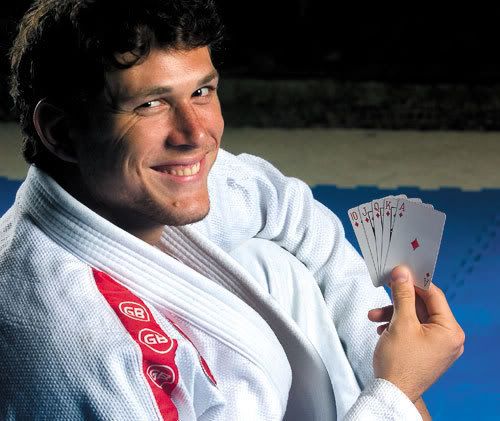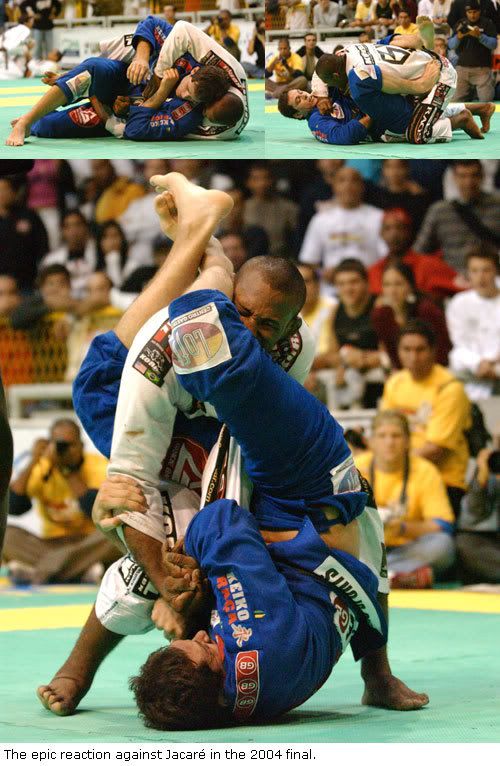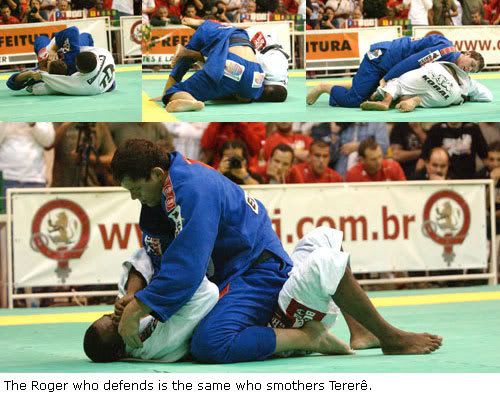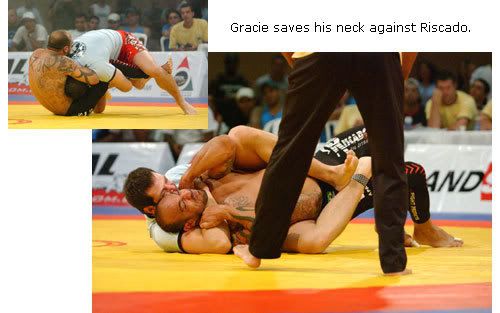Roger’s secret

Photos by Gustavo Aragao
He is the greatest in submissions nowadays, but that’s well known. What sometimes goes unnoticed are his refined defensive techniques, which provide the base for his Jiu-Jitsu and balance his game. Learn it and enjoy it.
It was Xande Ribeiro who tipped it off. During an informal chat at his black-belt friend Paulo Guillobel’s apartment, in San Clemente, California, Ribeiro talked about the virtues of Roger Gracie, his greatest opponent at the 2006 Jiu-Jitsu Pan-American Championships: “The amazing thing about Gracie is that he is able to recover from positions that you think are stabilized, but he proves them otherwise.” Ribeiro didn’t notice but the remark called the attention of a couple of GRACIE Magazine reporters who happened to be there.
The remarks made by Saulo Ribeiro’s brother immediately related to an exclusive statement given by Marcelo Garcia minutes after being defeated by Gracie at the 2004 World Jiu-Jitsu Championships’ open-class final. Despite being at a disadvantage from the beginning, Garcia had reached his favorite position, an attack from the back that is usually deadly, but Gracie managed to escape. ”His hand was on the same path as mine. I had no chance. Is it because he is heavier and stronger? I didn’t feel that. He is very skilled,” said Garcia.
Gracie would later escape from two other extremely uncomfortable positions in the same World Championship: a choke from the back by Fernando Tererê (“I defended Tererê’s second hook with my elbow and with a leg movement while my chin protected my neck”) and a grab from the back (with two hooks locked) from Ronaldo Jacaré, winner of open-class category.
Those three defenses by Gracie were very hard struggles, displays of incredible skill, but the people at Tijuca tennis club, where the championship was being held, didn’t even get very excited about it. It is only natural that fans give more attention to whoever is attacking and don’t care much about who is defending. But to do that when Gracie is fighting is the same as closing one eye. You will only see half of his technique.
Roger is just like Rogério Ceni, best goalkeeper in the history of São Paulo football club, who is not only great in saves but also became an expert on long range penalty kicks, to the point of becoming one of the team’s top scorers. Much in the same way, the black-belt in question is the most efficient in submissions among his generation’s stars, and knows how to defend with the same skill. By the way, Gracie thinks that when you improve your defense techniques you are improving your attack in the same measure and vice-versa.
Below, the current open-class Pan-American champion teaches a lesson on Jiu-Jitsu defense mechanisms. Never before had a news team come so close to the sleeves of Roger Gracie’s gi, where he keeps not only his spells but also his antidotes.
How did you develop such good defense?
By tapping out [laughs]. Since I was a child I trained with black-belts and they never took it easy on me. I was always tapping out so that’s how I began developing ways of escaping the submissions. I never had much muscular power so I relied on technique alone. It would be impossible to escape those attacks based on explosion or strength. There was an incredible team of black-belts at the gym when I was a blue-belt: Nino Schembri, Roberto Roleta… I had to develop escapes for some of the most dangerous Jiu-Jitsu attacks of those days. Of course I had the help of very skilled masters like Carlinhos, my father [Maurição], Renzo and Rillion…
You have finished Jacaré, Saulo, Margarida, Xande, Tererê, Comprido and many more. Don’t you find it odd that we are so interested in your defense despite you being the greatest in submissions nowadays?
Actually, attack is directly linked to defense, and vice-versa. Whenever I’m trying to finish someone I pay attention to the movements my opponent makes to defend himself and analyze those moves that block efficiently my attacks. So I reuse my opponent’s moves when I’m drafting my defense. The same thing happens when I’m defending. I try to perceive which movements are able to break my defense and improve my attack strategy.
You are referring to the balance in Jiu-Jitsu, the balance between attack and defense. We have the impression that there are a lot of black-belts that are good attackers but have extreme difficulties whenever they need to defend themselves from a lock or a choke. They don’t know how to react that well. Do you agree?
What I see is a lot of fighters that rely exclusively on muscular explosion and strength to escape attacks. The problem is when they get tired. Then, there’s no other way than to tap out. There’s another problem related to that. When you are accustomed to using power and explosion to escape, you don’t learn about the mechanism of the move. The trick is to understand the reason of things, to know why the choke is pressuring or not. That way it is easier to find the position that offers the main support point to the opponent’s lever.
Which is the most difficult position to defend oneself from?
I think that the more locked the move is the more difficult the escape is. I believe that maybe the rear-naked choke is the most difficult move to be defended, as it usually presents the most difficult-to-break grip.
Which was the most difficult defense you ever performed?
Well, the tightest move I’ve ever been caught in was Xande Ribeiro’s triangle in the latest Abu Dhabi [ADCC, no gi championship]. Definitely that was the most difficult situation I have ever found myself in but at that given moment Ribeiro lowered one of his arms and I managed to pass my leg and sit, getting free from the pressure.
Your elegant posture makes it looks almost like an English sport, although it’s called Brazilian Jiu-Jitsu. It reveals a lot of coolness and patience during fights, a lot different from the more agitated Jiu-Jitsu that we see a lot these days. Does that posture help you to defend?
Patience is the key to Jiu-Jitsu. I like the metaphor about the guy that is drowning. If he starts to flap his arms and legs, he is going to lose oxygen quicker and won’t think straight. To swim like that will make him sink to the bottom, but if he is calm he can come to surface easily. The same applies to Jiu-Jitsu. If the guy that is being attacked starts to move randomly trying to escape, he may simply be moving to adjust the position for his opponent, to tighten the move.
(Read Part 2)






















No comments:
Post a Comment